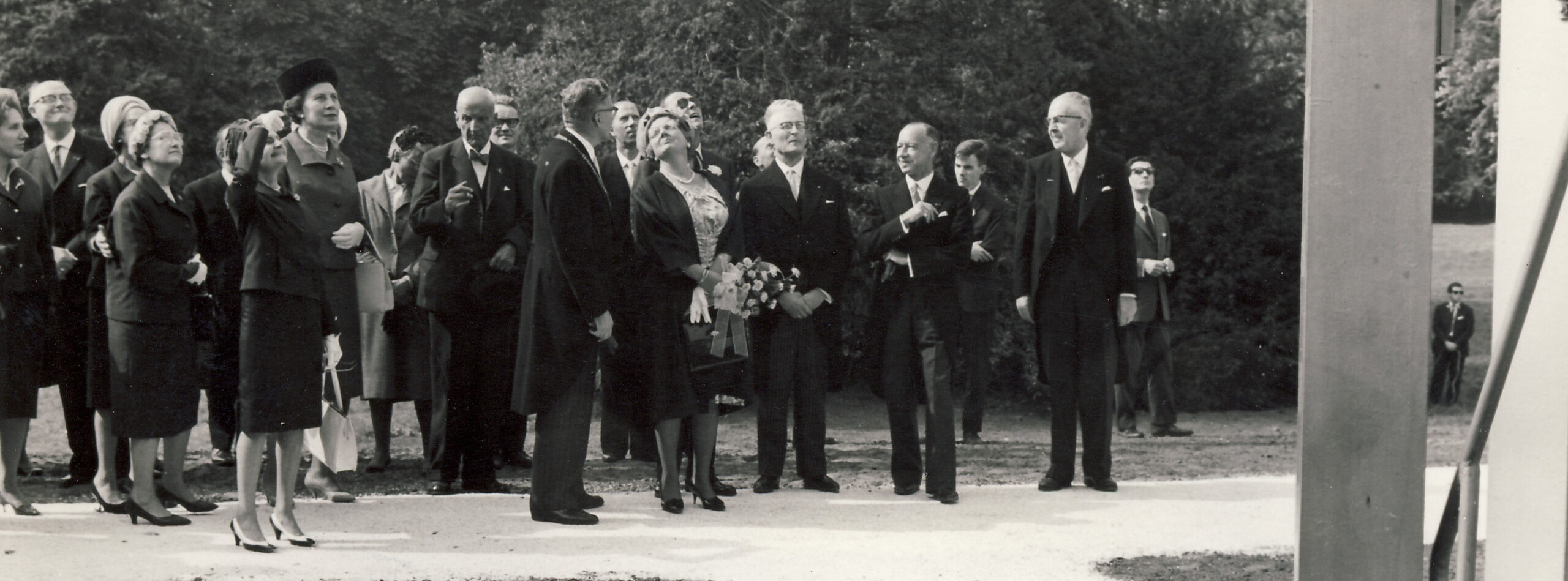
CAMPUS CARILLON
A UNIQUE GIFT
In 1961, it was announced that the third Dutch technical university would be located on the Drienerlo estate. At that time, the carillonist of Enschede, Dick van Wilgenburg, had already been looking for a new destination for ten bells that had been out of use since 1950. They are the ten smallest bells cast in 1929 by Gillett & Johnston of Croydon, England, for the carillon in the tower of the Grote Kerk. In 1943, 32 of the 42-bell carillon were requisitioned by the German occupying forces.
Van Wilgenburg comes up with the idea of including the ten bells in a park carillon on the grounds of the new Technische Hogeschool Twente (THT). The proposal is submitted to the Enschede city council. Eventually, the Belangengemeenschap Twente / Oost-Gelderland (TOG) decides to donate a completely new carillon to the THT.
A teahouse owned by the former owners of the Drienerlo estate then still stands on the site where the carillon would be.
The bell tower is not only an icon, but also a symbol of the connection of the UT with the region.
Initially, there are even plans to build a cultural-spiritual reflection centre with a carillon on this site, a small hill in the park, designed by the well-known architect Gerrit Rietveld.
Regarding the design of the tower, a consultation between Gerrit Rietveld and ir Willem van Tijen, one of the two chief architects of the college, also attended by some representatives of the Royal Bellfoundry Eijsbouts in Asten, took place in Utrecht on 14 February 1964.
Rietveld appeared to prefer a simple closed cylinder to minimise the tranquillity of the park. Van Tijen had a tower as a steel structure in mind. Based on these consultations Leo van der Aa, chief structural engineer at Royal Eijsbouts in Asten at the time, made an initial design for an open octagonal steel structure about 21 metres high with a spiral staircase in the middle and the playing cabin at the top. This first design was then slightly modified by Rietveld's architectural office to produce the final result.
In 1964, Eijsbouts cast 49 bells for the THT. This involved melting down the ten small Gillett & Johnston from the Grote Kerk and using them as raw material for the new carillon. The tower is transported from Asten to Hengelo in two large sections by barge in early September. Two trucks from the Hengelo firm Van Wezel, partly under police escort, move the tower to the campus. The transport attracts a lot of attention on the way!
On campus, the lower section is attached to the foundation by anchor bolts, after which the second section is put on top using a large crane. Soon after the tower is erected, the bells are hung in the crown of the tower.
Incidentally, the cultural-spiritual reflection centre was never realised, partly because of Gerrit Rietveld's death in June 1964. Dick van Wilgenburg, the man who had set everything in motion, did not live to see the inauguration either. He died in mid-August 1964.
Inauguration
On 14 September 1964, Queen Juliana and Prince Bernhard opened the Technische Hogeschool Twente. During the royal couple's tour, the mayors of the Belangengemeenschap Twente/Oost-Gelderland offered the exceptional gift: a tower with a carillon of 49 bells, commemorating the joint lobbying by all of the eastern Netherlands for a university of applied engineering sciences in this region. The largest 30 bells bear the names of the municipalities that donated the respective bells, as well as the year 1964, the donors' emblem, and a decoration.
That day, Karel Borghuis, city carillonist of Oldenzaal, performed the first festive recital. After being introduced to the Queen, he climbed the tower and began his play with the time-honoured 'Gaudeamus Igitur'.
The representative of the TOG community, former mayor of Eibergen Leo van Wensen, once again emphasised at the inauguration the growing bond between the university and its surroundings:
"May the carillon radiate its harmonious sounds to all winds as a sign of the interconnectedness of all those who together have to carry the community of the THT and to a strong and growing connection with the region and population of Twente and Oost-Gelderland."